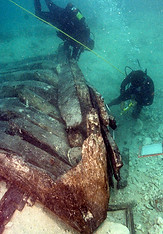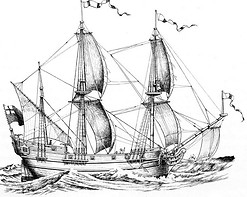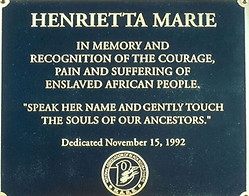
The Mel Fisher Maritime Museum is a 501 (c) (3) accredited, not-for-profit organization existing to research, interpret, and exhibit the maritime history of Florida and the Caribbean in ways that increase knowledge, enrich the spirit, and stimulate inquiry.
Archaeology & Research / More ... Henrietta Marie...
The Henrietta Marie an English Merchant Slave Ship, wrecked 1700
The ship was much more important than they hoped. On most ships of the period, one or two sets of iron shackles were carried to punish sailors who might misbehave, but the large number found on this site was unusual, evidence that the vessel had a large number of captives. Then came an enormous breakthrough - a diver discovered the ship’s bell. The cast bronze bell was heavily encrusted with concreted sand, sediment and coral. When the crew gently chipped this covering away, something remarkable was revealed -- the means to identify the long-lost ship beyond a shadow of a doubt. "THE HENRIETTA MARIE 1699" was cast in block letters around the bell’s waist. The identification brought a startling immediacy to the excavation. Once English and Jamaican shipping records confirmed the vessel’s status, the wreck’s significance was apparent - the Henrietta Marie was the wreck of an early slave ship!
The identification allowed researchers to use historical records to begin reconstructing a little-known passage in American history. Early in the research process, records were uncovered showing that the Henrietta Marie was a London-based vessel, registered at 120 tons burden. Sturdy and fast, she traveled the infamous triangular trade route favored by the slavers - from England to the West African coast, to the Americas, then home again.


Accounts relating to the Henrietta Marie’s voyages were uncovered, as were the names of her investors, captains, and wills of some of her crew members. Artifacts found at the site proved particularly helpful in creating a picture of shipboard life and the practices of the slave trade. In 1986, Mel Fisher donated the artifacts from the wreck to the not-for-profit Mel Fisher Maritime Heritage Society. Under the MFMHS, research has continued both with the collection of recovered items, and in the field.
Today, the Henrietta Marie is believed to be the world’s largest source of tangible objects from the early years of the Transatlantic Slave Trade. As such it has proved to be an abundance of information about a pivotal period in African, European and American history. Artifacts from any aspect of the maritime slave trade are extremely rare. Among the objects found at the site of the Henrietta Marie are over eighty sets of shackles, two cast-iron cannon, glass trade beads, stock iron trade bars, ivory "elephant’s teeth," and a large collection of English made pewter tankards, basins, spoons and bottles. The partial remains of the ship’s hull have allowed for an understanding of the ship itself. An equally valuable "treasure" is less tangible: the wealth of information researchers have been able to uncover about the complex maritime slave trade and the roots of racial inequality that still exist today.
In May of 1993, the National Association of Black SCUBA Divers placed a memorial plaque on the site of the Henrietta Marie. The simple bronze marker, which faces the African shore thousands of miles away, bears the name of the slave ship and reads:
"In memory and recognition of the courage,
pain and suffering of enslaved African people.
Speak her name and gently touch the souls of our ancestors."


Two years later, in May of 1995, the Mel Fisher Maritime Heritage Society unveiled "A Slave Ship Speaks: The Wreck of the Henrietta Marie." The first major museum exhibition in this country devoted to a ship engaged in the transatlantic slave trade, it was prepared with the assistance of the nation’s leading scholars of African-American history. The critically acclaimed exhibition used the vessel as a focal point to examine the slave trade, the conditions that spawned it, and its still-evident effect on society. The exhibition toured the US and Caribbean for nearly 20 years and was seen by over 3 million people.
Beginning in 1998, the Mel Fisher Maritime Heritage Society teamed with the RPM Nautical Foundation to continue research at New Ground Reef and on the wreck of the Henrietta Marie. Over the next four years, extensive magnetometer surveys were conducted to find missing sections of the slaver. Unfortunately, the rest of the Henrietta Marie could not be located. In May of 2000, though, the slave ship’s wooden hull, first located in 1972, was fully uncovered, mapped, and photographed – an effort that was featured in National Geographic magazine.
Today, an exhibit about the Henrietta Marie is a highlight of the Key West museum. A traveling exhibit called “Spirits of the Passage” also features many items from the Henrietta Marie, as well as other materials from across the long history of the Transatlantic Slave Trade, so people can continue to see and learn about the ship and its business.

Dr. Colin Palmer, author of Human Cargoes and The African Diaspora, is a professor of history and one of the scholars whose work has contributed to the knowledge of the Henrietta Marie. He believes that an understanding of the slave trade is vital if race relations are to progress beyond their current uneasy state. "The story ends in 1700 for this particular ship, but the story of what the ship represented continues today," he says. "The importance of the Henrietta Marie is that she is an essential part of recovering the Black experience - symbolically, metaphorically and in reality."






